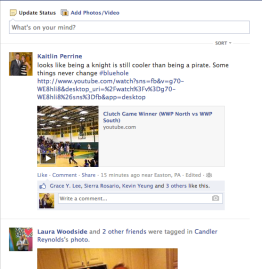From Bards to Blogs
Overview
Chapter 2 in Rettberg’s book talks about the history of mass media and how it has developed into blogging. Blogs changing the way we communicate and how information is spread. Audiences used to be passive, but the Internet has completely changed the game. We have gone from followers to leaders – anyone can create the news. We no longer rely on a few powerful groups to decide what is important and report on it.
Orality and Literacy
Orality, as mentioned in my blog response to the work of Gregory Ulmer, mark the beginning of communication as it exists today. Literacy was the first real transition in the field, and as with any new technology, people were skeptical. People may resent the move from writing to blogging, but electronic media touches on both orality and literacy.
Plato’s Complaints
This distrust of changes in communication is not unique to electronic media – it also happened with the invention of writing. Plato, one the history’s greatest scholars, was afraid that the practice of writing would ruin memory.
This is true, as I notice the difference in memory between my dad and me. I cannot go anywhere without my phone’s GPS to guide me, but my dad memorizes his route on a paper map before he leaves. I see no point in doing this when I have access to my phone, which can easily direct me (although sometimes Siri does get me a bit lost). However, the benefits definitely outweigh the risks.
Another one of Plato’s complaints about writing was that it removed the interactive element of conversation. The Internet has brought this back and even expanded on it. The bloggers themselves can constantly edit and correct their work. They also allow readers to comment and help make corrections or share opinions. This makes the blogs more conversational.
Introduction of Print
The printing press, which was first invented by the Chinese, comes into our story with its introduction to Europe by Gutenberg. It made printing more flexible, quicker, and less expensive. It expedited our cultural move from orality to literacy.
Cultural Changes of Print:
- Dissemination – instead of going to the information, it could come to you
- Standardization – printing became systematic and errors became less frequent
- Reorganization – developed standards that text should have
- Data Collection – collaboration allowed for more accuracy
- Preservation – more copies, more likely to last longer
- Amplification and Reinforcement – go back to old texts for support
Print, Blogging and Reading
As the introduction of writing increased literacy, blogging has influenced a different kind of literacy. This understanding of the Internet is now being called network literacy, multi-literacy, digital literacy, secondary literacy, and electracy.
Since the Internet is worldwide, people from opposite sides of the globe can read the same document at the same time and interact with it. I know with my YouTube channel I was shocked by the viewers and comments I would get from different countries. I think it’s amazing that I can have viewers from every country from Japan and Indonesia to Belgium and Brazil.
Print Inventions for Different Centuries
| 1600’s | 1800’s | 1900’s | 2000’s |
|---|---|---|---|
| Pamphlets Periodicals | Personal Newspapers | Photocopies (Newsletters) | Blogs |
Blogs are faster, easier, and more interactive than photocopying documents.
The Importance of Print
Print is still one of the most important modes of communication, especially for schools. The Internet can be distracting, whereas print media fully holds our attention. However, the latest concerns are about the diminishing time we spend reading versus using electronics. I know as a college student I don’t have time to read books for leisure, yet I still somehow always have time to surf Buzzfeed.
A Modern Public Sphere?
Public Sphere: a space for democratic debate between the government and the (informed) people. If any technology has come close to achieving this space, it is the Internet. Whereas radio and television previously inhibited the conversation in a public sphere, with their combination with the Internet, they have allowed the everyday person to participate.
Hypertext
Before its invention, hypertext was talked about as a more efficient way of thinking. It was in 1965 that Ted Nelson formally defined it as a type of hypermedia.
Goal: to perform a request
Form: displayed on computer screen (not on paper)
Qualities: interconnected and complex
Style: succinct and chunked
Mode of Action: links
Do we shape technology, or does it shape us?
Here are two theories:
Technological Determinism: technology determines the path of our society and culture
Co-construction: technology and culture depend on each other
Which one do you think it is? Please leave comments!
Blogs, Communities and Networks
Overview
An audience, no matter how big or small, matters. Bloggers write with their audience in mind, whether it is 5 or 5 million people. It involves small audiences and many producers.
Key Terms
Social software: built to support networks of social interaction
Examples
| Blogs | Social Software |
|---|---|
| Free-form | Centralized |
| Decentralized | Single server |
| Many domains | One domain |
| Actively connect to other blogs | Automatically provides links |
Social Network Theory
The theory states that the weak ties between people are more important that the strong ties of the spread of information. These links cross multiple social groups, as people connect (through these weak ties).
I’m sure you’ve all heard of the “six degrees of connection”, which states that we are all only six people away from knowing any other individual in the world. Am I really six people away from knowing someone who lives in Indonesia, or a celebrity? This is where the Internet comes into play. People can share, especially with their weak ties.
Blogs are especially important with forming ties, whether they are weak or strong. A blogger can link to other blogs without knowing the writers – he may just be a fan of their work. There does not have to be a strong personal tie in order to link on a blog.
Rettberg cites fashion blogs as a great example of this, and I completely agree (maybe I’m biased – I love clothes). They post pictures of everyday people on the street who they think are best dressed. Harper’s Bazaar: Street Style does a great job doing this, showing how trendy people are dressing from all around the world. Fashion bloggers also link to other fashion blogs, creating a social network founded on the same weak ties mentioned earlier.
The Internet has allowed the concept of the social network to flourish beyond what was originally thought possible. Individuals who don’t know each other, but engage in the same network, form the connections. Blogs help spread ideas and information that otherwise would be limited to certain social groups. In the fashion world, this facilitates the spread of trends, because people can see what is popular even if no one around them is wearing it.
Distributed Conversations
As we had talked about distributed systems in my computer science class last semester, Rettberg talks about their importance regarding social networks. When a network is spread across multiple machines, it is less vulnerable to malfunctioning. If one computer goes down, the other ones will keep the network functioning properly.
Blogs fall into this distributed, decentralized category, as blogs from many different domains link to each other. Since everyone can publish, the distribution of links is nowhere close to equal. The most popular blogs receive many more links than a smaller blog (like mine). Since they are already so popular, these major blogs are likely to continue to make more and more connections.
Technology for Distributed Communities
Blogging may not be in real time like face-to-face conversation, but its ability to post to the Internet (and stay there) makes up for that. Since it is not in real time, blogs value immediacy. This is why they post in reverse chronological order. People want to see the newest post, as that is what the conversation has turned to now.
However, the nature of the conversation has changed. As blog posts last for long periods of time, so do comments. This can lead to a conversation that spans hours, days, or even weeks. This is an advantage blogging conversations have over live ones. Most of them actually take place very quickly, due to the speed of the Internet and the importance of the issue at hand.
If a tree falls in an empty forest does it make a sound? If you blog without any readers, are you really blogging? This is why you need to link to other blogs and encourage reader feedback.
Other Social Networks
Facebook is a bit different from having different blogs connect, because every profile is located under the same domain name. However, the News Feed function does work like a blog. The most recent actions are posted to the top of your News Feed.

